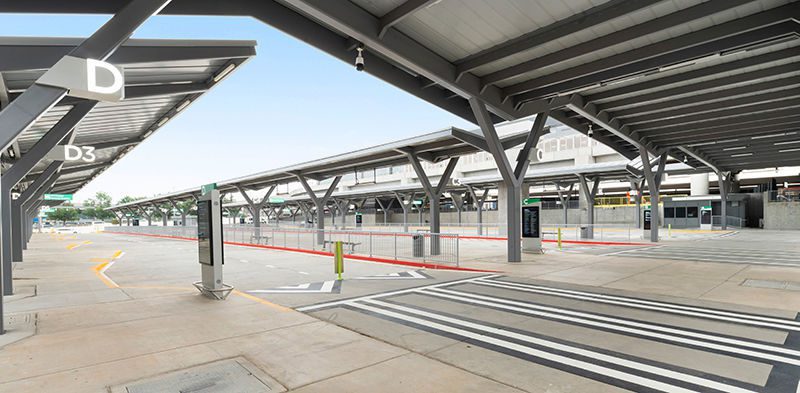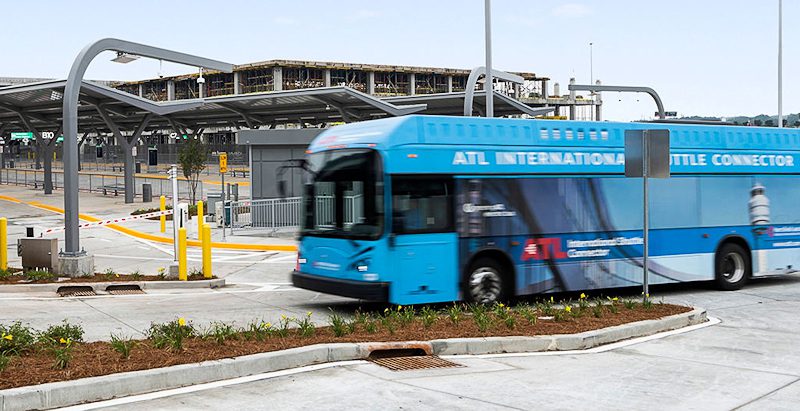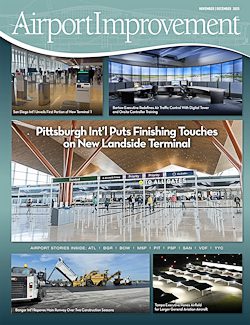Hartsfield-Jackson Atlanta International Airport (ATL) recently reconfigured its terminal roadways and constructed a new area near the domestic terminals exclusively for commercial ground transportation providers. The $56 million Ground Transportation Center project created a designated area with canopies and islands to centralize service by taxis and shuttles for hotels, off-airport parking facilities, airline crews and regional transportation operators.
The changes don’t just benefit arriving and departing passengers. The airport and its project team also designed the improvements to reduce roadway congestion and increase safety for airline crews and other personnel commuting to and from work at the airport.
“Customers can now conveniently access shuttle or taxi services by heading to this unified location,” says Ana Maria Taroco, assistant general manager of infrastructure planning and development for the airport. “With designated aisles, the GTC [Ground Transportation Center] provides dedicated spaces for shuttle and taxi pick-up and drop-off, positioned ahead of the main terminal to reduce congestion at the terminal curbside.”
| facts&figures
Project: Ground Transportation Center Location: Hartsfield-Jackson Atlanta Int’l Airport Cost: $56 million Funding: Airport revenue (100%) Project Timeline: Installation of underground utilities & sitework began in 2019, then paused for another landside project; construction resumed in 2022 & ended summer 2025 Strategy: Reconfigure roadways; relocate & consolidate shuttle & taxi operations Construction: Clark Construction, Atkinson Construction & Technique Joint Venture Engineering & Architecture: ABSolute Joint Venture of AtkinsRéalis for project management, architecture, canopy structural, mechanical/electrical/plumbing, pavement & roadway; Brindley Pieters & Associates for utilities & retaining wall structural; Southeastern Engineering Inc. for drainage Special Systems, Design, Technology: Burns & McDonnell Electrical: Key Engineering Signage: Valancourt Int’l LLC Construction Administration: HKS/FC/S&W Joint Venture with subcontractor AtkinsRéalis as project manager & construction administrator Key Benefits: Enhances safety & efficiency; improves the passenger experience; reduces curbside congestion |
Philemon Bannis, P.E., senior engineer of Aviation at project partner AtkinsRéalis, describes the infrastructure improvements as a strategic redesign that puts people first.
“This isn’t just about convenience,” says Bannis. “It’s about safety, clarity and reducing stress. By streamlining access to ground transportation, the Ground Transportation Center helps minimize curbside traffic, shorten wait times and improve the overall flow of people and vehicles. As a global air traffic hub serving more than 100 million passengers annually, seamless access to and from the airport is vital to maintaining operational efficiency at ATL.”
Taroco further notes that the $56 million project was fully funded with revenue generated by, and solely for the use of, the airport, with no impact to passenger prices or airline fees.
The new Ground Transportation Center project is part of the airport’s multibillion-dollar ATLNext program launched in 2016 to prepare for continuing passenger growth. It is a comprehensive modernization and expansion initiative designed to enhance passenger experience, increase capacity and maintain the airport’s status as the world’s busiest airport. The program encompasses a series of projects, like the GTC, to transform both landside and airside facilities to accommodate future growth and evolving travel needs.
Improving Flow
The new Ground Transportation Center layout centralized taxi and shuttle operations with no changes to ConnectATL, the airport’s shuttle service between the domestic and international terminals.
“During the design phase, factors such as peak travel hours and dwell times for various other modes of transportation were carefully considered,” says Bannis. “The GTC helps maintain a steady flow of traffic for shared-ride users and provides a covered space for safe, quick and convenient access to designated pick-up and drop-off locations.”
Assignments are organized by aisle and zone to better manage passenger pick-up/drop-off locations and improve traffic flow. New stall assignments were phased in this June as part of ongoing improvements to the West Curb.
The airport added extra signage and staff direction to help passengers adjust to the new locations and system. These improvements are part of ATL’s broader effort to optimize ground transportation and deliver a more seamless airport experience.
“Travelers no longer need to hunt for their ride or wade through curbside confusion,” says Bannis. “Instead, they’re guided through a clear, intuitive path that connects them quickly to hotels, parking and regional transit options.”
Taroco notes that studies and projections informed the airport’s goals, including the need to accommodate larger shuttle vehicles and making viable use of available space for prearranged pick-ups. Alleviating traffic congestion where shuttle pick-ups were previously located emerged as a key priority. The area was very narrow and situated between the main domestic terminal and the station for SkyTrain, which takes customers to/from the Rental Car Center. When large crowds of SkyTrain riders would use the cross walks, lengthy delays were created for ground transportation vehicles, causing congestion on the main roadway system. Although the new Ground Transportation Center is located in a similar location, these conflicts were engineered out.
Establishing a single location for shuttle and taxi services, with the SkyTrain station for rental car customers in the same area, provides a central place on the west side of the main terminal where customers access ground transportation.
“Whether catching a shuttle, hopping in a taxi or heading to your rental car, it’s all right there, streamlined and accessible,” says Bannis. “Even rideshare services, though located separately from the West Curb, have been thoughtfully integrated into the airport’s traffic flow. Their designated access point is engineered to reduce curb side congestion, ensuring that every mode of transport contributes to a more efficient and positive journey.”
Guests using rideshare services such as Uber and Lyft meet their vehicles in an area adjacent to the North Domestic Terminal separate from the new Ground Transportation Center.
Phased In
The new Ground Transportation Center was completed in multiple phases during the course of several years.
Phase 1 of the construction began in 2019 and included preliminary sitework and installation of underground utilities. Sitework paused for several years during excavation for another major ATLNEXT project: a tunnel to extend the Plane Train system that connects all of ATL’s terminals and concourses. After aboveground work on the tunnel was completed, crews began Phase 2 of the GTC project in 2022. That work included the remaining drainage system, pavement, canopies and other infrastructure. Substantial construction was completed in early Summer 2025, before the start of the busy travel season, notes Bannis.
 The new area directly west of the domestic terminal via a walking path is a significant enhancement for guests, notes Taroco. “The previous [area] was congested, undersized and had inefficient ingress and egress points. This streamlines vehicle circulation, and creates a safe and efficient pedestrian flow from the terminal to the GTC.”
The new area directly west of the domestic terminal via a walking path is a significant enhancement for guests, notes Taroco. “The previous [area] was congested, undersized and had inefficient ingress and egress points. This streamlines vehicle circulation, and creates a safe and efficient pedestrian flow from the terminal to the GTC.”
Before the recent transformation, passengers arriving at the airport’s domestic terminals often faced a maze of curbside congestion, long waits and unclear directions.
“Now, travelers step into a centralized, intuitive space designed for ease and speed,” Bannis contrasts. “With protective canopies and clearly marked islands, the GTC offers dedicated zones for shuttles, taxis, hotel transport, off-airport parking, airline crews and regional operators, all just steps from the terminal. Together, these improvements reflect a commitment to making ATL not just a gateway to the world, but also a model of modern airport mobility.”
Taroco describes the new Ground Transportation Center as an extension of ATL’s commitment to delivering world-class service and a manifestation of its pride in ensuring operational efficiency. “The area was designed with customer experience in mind,” she comments.
 An enhanced hold lot for commercial vehicles meters traffic flow to help reduce dwell time and congestion, thus improving service reliability. “It’s a behind-the-scenes powerhouse that keeps things running smoothly,” Bannis remarks.
An enhanced hold lot for commercial vehicles meters traffic flow to help reduce dwell time and congestion, thus improving service reliability. “It’s a behind-the-scenes powerhouse that keeps things running smoothly,” Bannis remarks.
The lot includes bright LED lighting, enhanced wayfinding signage powered by digital technology, additional pedestrian railings to increase passenger safety and improve traffic flow, and a series of canopies over waiting areas to shield customers from weather. “These canopies were architecturally styled to resemble airplane wings, thereby providing a whimsical design element to the space that complements the nearby SkyTrain,” adds Bannis.
Meeting Travelers’ Needs
The main goal of the new Ground Transportation Center is to provide a safer, more efficient experience for airport customers while also creating an inviting and welcoming environment. Thus, travelers’ needs were a top priority before, during and after design and construction.
“One of the greatest challenges was maintaining airport operations in the area while continuing construction progress,” recalls Taroco. “This included preserving access to the terminal and the existing shuttle area.”
Bannis agrees, noting that the stakes were particularly high in such a high-traffic area. “With thousands of passengers moving through the domestic terminals daily, even minor disruptions could ripple into major delays,” he remarks.

Canopies protect guests and workers from inclement weather while they wait for shuttles and taxis.
To overcome these challenges, collaboration among those working on the project was key. And there was much collaboration. During design, there were multiple meetings held with the airport team, airport ground transportation and other stakeholders to review the Ground Transportation Center layout and operations. Planning and coordination were emphasized early in the process.
Clark Construction, Atkinson Construction and Technique combined their skills in a joint venture on the construction side. ABSolute, a joint venture of AtkinsRéalis, Brindley Pieters & Associates and Southeastern Engineering Inc., handled the various engineering aspects. (See Facts and Figures box on Page 27 for specific duties.) Burns & McDonnell oversaw special systems as well as design and technology. Key Engineering was responsible for electrical. Valancourt International LLC provided signage. And HKS/FC/S&W Joint Venture, with AtkinsRéalis as a subcontractor, handled construction administration.
Taroco praises the collaborative efforts of the airport, contractor and design teams. She also highlights the importance of strategies such as modifying Maintenance of Traffic (MOT) plans, working overnight shifts and adjusting work schedules around peak travel seasons. “Particular care was taken to make sure access to the SkyTrain Station and nearby dog park were maintained during construction,” she adds.
“The airport, contractor and design teams worked hand-in-hand to anticipate and overcome logistical hurdles,” Bannis remarks. “Maintenance of Traffic plans were continuously refined, overnight shifts were scheduled to avoid peak hours, and construction timelines were carefully aligned with travel seasons to minimize impact.”
He further points out that into this was incorporated a progressive design-build project with a single design-build contractor managing multiple packages, including the Ground Transportation Center and Plane Train Tunnel Extension.
“While the contractor led certain aspects of the project, key components like the Ground Transportation Center were designed by the AtkinsRéalis team [under the strategic oversight of Frank Rucker, senior deputy general manager of Infrastructure Planning and Development], ensuring a balance of innovation, oversight and accountability,” Bannis explains. “The result? A complex project delivered with minimal disruption and a transformed traveler experience that reflects the power of strategic planning and true partnership.”



